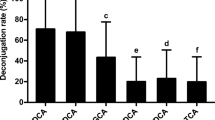Summary
The purpose of this report is to present the deconjugation of bile acids by numbers of strains of bacteria in the small intestine and feces. The small intestinal juice was aseptically aspirated by a double lumen tube with a rubber cover on the tip devised by us (“Fukushima Type 1”). Bile acids were analyzed with thin layer chromatography. The results: 1) Among aerobic bacteria, species of which all of the strains split conjugated bile acids was enterococcus, and most of the strains split were Staphylococcus (S.) epidermidis and Lactobacillus (L.) bifidus. Species of which none of the strains split were Escherichia (E.) coli, E. communior, E. freundii, L. plantarum, L. acidophilus, L. buchneri, L. cellobiosus, L. bulgaricus, S. aureus, Aerobacter aerogenes, Pseudomonas aeruginosa, Candida, proteus, serratia, and almost none of the species split was Intermediate coliform bacilli. 2) Among anaerobic bacteria, species of which all of the strains split were Bacteroides (B.) vulgatus, B. thetaiotaomicron, B. uniformis, Corynebacterium (C.) granulosum, C. avidum, Peptostreptococcus (Peptostrept.) putridus, Eubacterium (Eubact.) lentum, Peptococcus (Pept.) grigoroffii, Pept. anaerobius, Veillonella (V.) orbiculus, and most of the strains split were Coryne. diphtheroides, Eubact. parvum, Peptostrept. intermedius. Species of which none of the strains split were Coryne. parvum, Peptostrept. micros, V. alcalescens, V. parvula, Catenabacterium (Catena.) catenaforme, and Catena, filamentosum. 3) All or none, or almost all or none, of the strains of each species tested split conjugated bile acids, and it seems probable that the presence or absence of this ability would be a proper character of each species.
Similar content being viewed by others
References
Gerson, CD., Cohen, N. and Janowitz, H.D.: Small intestinal absorptive function in regional enteritis. Gastroenterology, Vol. 64, No. 5, p. 907–912, 1973.
Kern, F. Jr. and Meihoff, W.E.: Bile salt excretion in certain diarrheal states: Bile salt metabolism, Chapter 23, p. 284–296, Charles C. Thomas, Illinois, 1969.
Finegold, S.M.: Intestinal bacteria—The role they play in normal physiology, pathologic physiology, and infection. Calif. Med., 110: 455–459, 1969.
Donaldson, R.M.: Jr. Normal bacterial populations of the intestine and their relation to intestinal function. New Eng. J. Med., 270: 938–945, 994–1001, 1050–1056, 1964.
Donaldson, R.M.: Jr. Studies on the pathogenesis of steatorrhea in the blind loop syndrome. J. Clin. Invest., 44: 1815–1825, 1965.
Polter, D.E., Boyle, J.D., Miller, L.G., M.A. and Finegold, S.M.: Anaerobic bacteria as cause of the blind loop syndrome. Gastroenterology, 54: 1148, 1968.
Tarao, K.: Anaerobic bacterial flora of small intestine in non-hepatic and hepatic diseased patients. Nippon Schokakibyo Gakkai Zasshi (Jap. J. Gast.), 66: 12, 1414–1423, 1969 (Japanese with Englisch abstracts).
Saito, Y.: Aerobic bacterial flora of small intestine in hepatic and non-hepatic diseased patients. Nippon Schokakibyo Gakkai Zasshi (Jap. J. Gast.), 69: 2, 165–176, 1972 (Japanese with Englisch abstracts).
Norman, A. and Grubb, R.: Hydrolysis of con-jugated bile acids by clostridia and enterococci. Bile acids and steroids 25. Acta Path. Microbiol. Scand., 36: 537–547, 1955.
Bergey’s Manual of Determinative Bacteriology 7th Ed. Williams and Wilkins, Baltimore, 1957.
Schaub, I.G.: Identification of gram-negative bacilli, Diagnostic Bacteriology, 5th Ed. p. 134–167, The C.V. Mosby Co., S.T. Louis, 1958.
Mitsuoka, T.: [Classification of lactobacillus]: Modern Media, Vol. 14, No. 2, p. 14–24, Nippon Eiyo Kagaku Co., Tokyo, 1968 (Japanese).
Kazuno, T.: Taisha (Metabolism and Disease), Vol. 2: p. 77–85 (867–875), Nakayamashoten, Tokyo, 1965 (Japanese).
Eneroth, P.: Thin layer chromatography of bile acids. J. Lipid Res., 4: 11, 1963.
Hofmann, A.F.: Thin layer adsorption chromato-graphy of free and conjugated bile acids on silicic acid. J. Lipid Res., 3: 127, 1962.
Eneroth, P. and Sjovall, J.: Extraction, purifica-tion, and Chromatographic analysis of bile acids in biological materials: The Bile Acids, Vol. 1, Chapter 5, p. 121–171, Plenum, New York, 1971.
Sidney, P. Colowick and Nathan, O. Kaplan: Methods in Enzymology XV, p. 77–88, Academic, New York, 1969.
Kazuno, T.: Kagaku no ryoiki, Extra No. 64, p. 19, Nankodo, Tokyo, 1964 (Japanese).
Ishikawa, M. et al.: [Thin layer chromatography], 4th Ed. Nanzando, Tokyo, 1970 (Japanese).
Nair, P.P.: Enzymes in bile acid metabolism: The Bile Acids, Vol. 2, Chapter 2, p. 259–271, Plenum, New York, 1973.
Drasar, B.S., Hill, M.J. and Shiner, M.: The de-conjugation of bile salts by human intestinal bacteria. Lancet, 1: 1237–1238, 1966.
Hill, M.J. and Drasar, B.S.: Degradation of bile salts by human intestinal bacteria. Gut, 9: 22–27, 1968.
Hill, M.J. and Drasar, B.S.: Degradation of bile salts by human intestinal bacteria. Gut, 10: 575–576, 1969.
Midtvedt, T. and Norman, A.: Bile acid trans-formations by microbial strains belonging to genera found in intestinal contents. Acta Path. Microbiol. Scandinav., 71: 629–638, 1967.
Midtvedt, T. and Norman, A.: Anaerobic, bile acid transforming micro-organisms in rat intestinal content. Acta Path. Microbiol. Scand., 72: 337–344, 1968.
Shimada, K., Bricknell, K.S. and Finegold, S.M.: Deconjugation of bile acids by intestinal bacteria: Review of literature and additional studies. The Journal of Infectious Diseases, 119: 273–281, 1969.
Sasaki, S.: [Physiology of resident flora], Nippon Saikin Gakkai Zasshi (Jap. J. Bact.), 25(2), 79–94, 1969 (Japanese).
Martini, G.A. et al.: The bacterial content of the small intestine in normal and cirrhotic subjects: relation to methionine toxicity. Clin. Sci., 16: 35–51, 1957.
Fukushima, K. et al.: [Effects of human intestinal flora on the bile acids and bilirubin metabolism] (abstr.), Nippon Naika Gakkai Zasshi (J. Jap. Soc. Internal Med.), 63, No. 8: 86–87, 1974 (Japanese).
Shindo, K. et al.: [Human intestinal flora and bile acids metabolism] (abstr.), Nippon Shokakibyo Gakkai Zasshi (Jap. J. Gast.), 71, No. 5: 69–70, 1974 (Japanese).
Author information
Authors and Affiliations
Rights and permissions
About this article
Cite this article
Shindo, K., Fukushima, K. Deconjugation of bile acids by human intestinal bacteria. Gastroenterol Jpn 11, 167–174 (1976). https://doi.org/10.1007/BF02777700
Received:
Accepted:
Issue Date:
DOI: https://doi.org/10.1007/BF02777700




